|
AIRCRAFT REVIEW Airbus vs Boeing: big questions from new small planesThe dapper single-aisle (Bombardier) A220 has passengers and accountants swooning as the Chinese C919 surprise entry took to the skies May 2023. Where does this leave the A380 vs B787 David and Goliath spat? As the A380 flies into the sunset how will the A220 stand up vs the B737? More on the ill-starred B737 MAX-8 that returned to the skies mid-2021. SEE ALSO First Class Seat Survey | Business Class Seat Survey | Economy Class Seat Survey | Small Airlines Guide | Frequent Flier Programs | Business Class Seats Review | Why the B737 MAX-8 Crashed | Covid-19 and the return of travel | Airline Bailouts 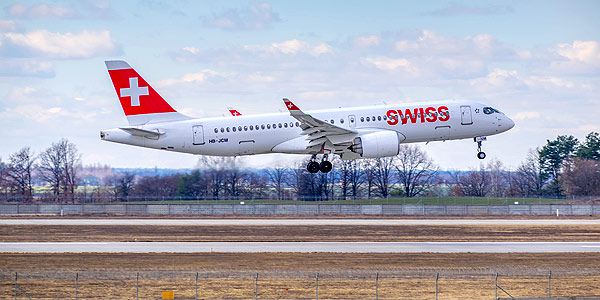
SWISS A220 touching down at Kyiv, Ukraine - a sleek single-aisle marvel with fly-by-wire perks, wider seats, and fuel economy to take on the B737 MAX. The Airbus vs Boeing battle continues.
IS BIGGER BETTER? Take these two. One was voluptuous and voluminous, combining the fulsome curves of a '60s Playboy model with the polish and poise of a portly dowager. Critics described her as a “dinosaur”. The other was sleek, pretty, and quick, yet capable of long outings. She was late to the ball and her antagonists derided her as incontrovertibly “plastic”. Both were modern, high strung, and elegant in their own way. They had charmed and alarmed in equal measure. Whom would you pick? The curvy A380, reminiscent of a chubby Botero sculpture, or the svelte B787 Dreamliner? For all intents it was a face-off between the alluring bloom of Christina Hendricks of Mad Men fame and the diminutive but seductive appeal of dark-eyed Natalie Portman. 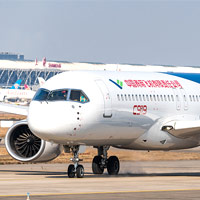
China's homegrown C919 takes on the B737 and the A320 But move over Airbus and Boeing. China's COMAC has rolled out its indigenous 164-seat single-aisle C919 passenger jet that took to the skies in May 2023. Any possible safety or efficiency concerns could easily be swept aside by the politics and allure of a homegrown option for China's crowded skies. The long grounding of the B737MAX after its tragic crashes, can only play in favour of the Chinese aircraft. As many as 1,200 tentative orders for the C919 have come in with China Eastern the launch customer. Critics argue that several key components are sourced from abroad. General Electric (USA) and the French Safran have provided the engines while other American firms are responsible for the flight-control system. The engines may go indigenous in time but the C919 may have some turbulent weather to negotiate in the interim. Back to the Airbus vs Boeing spat. It may appear prosaic, yet the story of this transatlantic argle-bargle – careening from the incredible to the insane – has all the ingredients of a rich period drama with bruised suitors, stiff upper lips, twists in the tale and the ever-present frisson of dark gossip surrounding wing cracks, battery smoke, government subsidies, and engine fires. Some history. {The largely indigenous C919 is designed to be a B737-killer and it is competing in China's crowded skies with the single-aisle A320NEO too... When longtime A380 white knight Emirates pulled the plug on orders in February 2019, the David vs Goliath tale was all but over, opening the 2020 skies to the small to mid-size aircraft market. And it is here where a dark horse - the 100-150-passenger C Series by the Canadian Bombardier - crippled by debt but staggering in its winsome, and modern fly-by-wire, appeal, quietly took centre stage at the 2015 Paris Air Show. Airlines were impressed with its fuel efficiency, roomy quieter cabin, improved storage, and technological wizardry. Two powerful Pratt & Whitney engines completed the mix. Immediately spotting its mid-size regional potential, Delta leaped in with a substantial order, prompting a peeved Boeing to launch a broadside at the fledgling aircraft. Boeing was later comprehensively outmanoeuvred by Airbus, which gained a majority stake in the C Series (renamed the A220) in October 2017. Earlier that year Comac, the Chinese state-owned aircraft manufacturer in need of fast-track hi-tech access, had also been in talks with Bombardier. 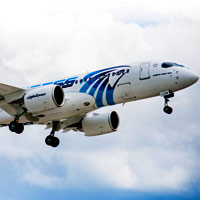
EgyptAir took delivery of its first A220-300 on 6 September, 2019 Boeing's schoolyard bully attempts to sully the airplane's reputation with charges that the Canadians were under-quoting on the price resulted in the Trump administration levying a crushing 300 percent duty on C Series jets. The story may have ended there but Airbus neatly sidestepped the punitive tariffs by announcing final assembly in the USA for American aircraft. Delta's first single-aisle A220-100 - in operation by February 2019 - received kudos from travellers for its wider seats, luggage space and fast WiFi. Airlines that have bought this passenger-pleaser jet since then include Air Canada, EgyptAir, Lufthansa, Gulf Air, Jet Blue, and Korean. Small is back in fashion. Or, rather, mid-size passenger jets are where the future is. So A220 vs B737 MAX? While the head-on competition from Airbus for the MAX comes from the A320Neo, the A220 is equipped to handle the competition admirably. It has wider seats than the B737 (seating 5 across and not 6) and comes with the latest in flying technology. Overall the B737 series can carry more passengers with stretch versions and more seats packed in making it a darling of airlines around the world with record orders. The A220 however has a longer range and requires shorter runways making it easier to penetrate various regions. Add to this the pert charms of the sleek WiFi-equipped A350 (not for no reason dubbed the B787 Dreamliner killer). On 11 October 2018 Singapore Airlines linked its very own tropical isle to New York with an A350-900ULR, the longest nonstop route in the world at 19 hours, beating the astonishing Qantas B787-9 Perth-London epic 25 March 2018 and the leg-numbing 17.5-hour Qatar Airways Doha-Auckland non-stop using a B777-200LR. All this has resulted in a flutter of plaudits, as well as alarm over passenger well-being across such long non-stop routes. 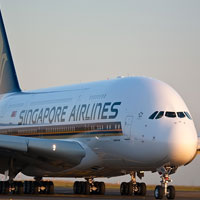
Singapore Airlines A380 double-decker. The sun sets on the gas guzzler. Much has been written about the transatlantic A380 vs B787 spat. The mammoth fly-by-wire A380 – the distillation of years of electronic eugenics – was pitted against the carbon fibre composite marvel, the B787. Who would win? Both the B787 and the A380 jumbo had their share of design dazzle as well as teething troubles. The hugely-delayed rollout of the Airbus A380 behemoth took place on 25 September, 2007, with a Singapore Airlines inaugural flight from Singapore to Sydney, a charity event that raised US$1.83 million for Medecins Sans Frontiéres and two children's hospitals, proving at once that airlines can have heart; and that the aircraft, while immense, was no gas guzzler, with 20 percent less fuel burn per passenger than a conventional B747-400 (now phased out). {The B737 MAX-8 had a software patch for what was really a design flaw - like sending a Sumo wrestler to a psychotherapist to convince him he can do ballet Then, on 4 November, 2010, a Qantas A380 suffered “catastrophic” engine failure over Batam, Indonesia, as one of its Rolls-Royce Trent 900 engines broke its casing, damaging the wing and forcing an emergency landing in Singapore. Qantas swiftly grounded its entire A380 fleet and SIA ordered checks. The Boeing 787 Dreamliner was delivered to the first recipient, a grateful and extraordinarily patient All Nippon Airways (ANA), on 25 September, 2011, a little over three years behind schedule, a substantial delay with huge costs that would prove critical later. 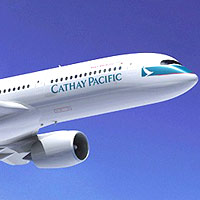
Cathay Pacific A350 offers WiFi But the Dreamliner drama had only just begun. On 9 January, 2013 a Japan Airlines aircraft was grounded at Boston's Logan International Airport after a malfunctioning battery in the aircraft's ancillary power system caught fire. Smoke had been discovered in the rear of the cabin. Another 787 sprung a fuel leak. On 16 January, 2013, an ANA B787 was diverted to Japan's Takamatsu Airport and made an emergency landing after a cockpit smoke alarm went off. Shortly after, both ANA (the largest Dreamliner operator at the time) and JAL, had grounded their B787 fleet. They were not alone. Worried about electrical fires and overheating batteries – the B787 runs almost entirely on electricity without the assistance of compressed air hydraulics – the Federal Aviation Authority (FAA) grounded the planes in USA. Europe and other airlines followed. Air India offered its Dreamliner up for sale-leaseback, not unusual in the airline world. At one stroke, the 50 aircraft in service had disappeared from the skies as attention turned to the Japanese lithium ion battery manufacturer, GS Yuasa Corporation. (Airbus prefers traditional nickel-cadmium power on the A350.) In mid 2019, when whistle-blower complaints focused attention on assembly lapses at the Charleston (South Carolina) Dreamliner plant where it was found that shoddy work had resulted in debris and tools rattling about in the aircraft fuselage, Boeing had its back to the wall. A once proud brand that had inspired the cheerful slogan, “If it’s not Boeing I’m not going,” wrestled with this fallout and other appalling PR gaffes relating to its handling of the B737 MAX8 crashes. All this has ensured the B-787 - a beautiful and quiet experience with humidified air and mood-lit cabins - remains profoundly in the red. 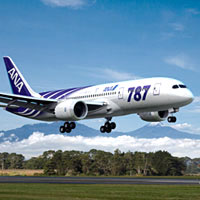
ANA was the launch B787 customer The minnows have been duking it out as well. Aircraft technology and design has made remarkable strides, alas almost none of it in the realm of passenger seat comfort. The B737 for instance that launched in 1964 with a cabin width of 11 feet and six inches and 124 seats, has extended the 'tube' but at exactly the same width for the B737 MAX10 with around 240 seats and with no respite on seat width which, by necessity, needs to stay at roughly 17 inches. The Airbus A321 and the A320Neos offer a modestly wider cabin that affords seat width of around 18 inches while the 200-seat A321XLR offers an extended 4,700km range for a long-haul single aisle run the manufacturer believes is well suited for India-Europe or China-Australia. The aircraft, with greater fuel efficiency and a stated 50 percent noise reduction, is expected to be in the air in 2023 and beats Boeing's NMA (New Midsize Airplane) with similar seating capacity but with a twin-aisle seven-abreast configuration due at the earliest by 2025. {Delta's first single-aisle A220-100 - in operation by February 2019 - received kudos from travellers for its wider seats, luggage space and fast WiFi ... Has technological wizardry got in the way of human skill and judgement as the B737 MAX-8 crashes suggest? The MAX-8 was rushed off the assembly line to compete with the Airbus A320neo. Sporting larger repositioned engines (altering the weight balance) and a naturally high angle of attack, low-power performance stuttered with a tendency to stall at slower speeds. Boeing's fix was to install an all new MCAS (Manoeuvring Characteristics Augmentation System) designed to bring an aircraft's nose down to increase speed and augment lift in low-speed situations. 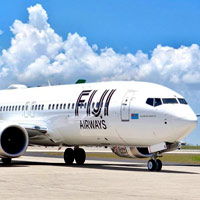
FIJI Airways B737 MAX8 twin-jet lines up for a tropical run During the flaps-out take-off phase as the ill-fated planes banked sharply before gaining speed the MCAS would have been triggered. A key problem was that the airline attempted a software patch for what was really a design flaw (like sending a Sumo wrestler to a psychotherapist to convince him he can do ballet). It was not all reassuring news then when Airbus disclosed in mid-2019 that scrutiny of its new generation A320Neo aircraft revealed it had a nose-up issue that required attention. While satisfied with the airworthiness of the A320Neo, the European Union Aviation Safety Agency (EASA) has suggested temporary changes to stabilise the centre of gravity on these aircraft while the manufacturer works on a software patch. What this means is the last rows are left unoccupied on certain aircraft and on others rear baggage holds are lightened. A quick rewind into the A380 vs B787 small versus big history. Send us your Feedback / Letter to the Editor Boeing believes large capacity aircraft flying to big, overcrowded, dispersal “hubs” are passé. Travellers want speed, frequency, and direct connections. They may well be right. The B787 Dreamliner (formerly the B7E7) was the result of Boeing’s preoccupation. The aircraft is swift and fuel efficient, with a cruising speed of Mach 0.85. It is smaller and can access regional airports without fuss. It also has a range that can extend to 16,000km carrying about 280 passengers. The good news for passengers is the B787 is pressurised for a lower altitude and with higher cabin humidity, which means you will not arrive at the other end looking and feeling like a desiccated peanut. Despite the original Boeing plan, it appears airlines have other designs. 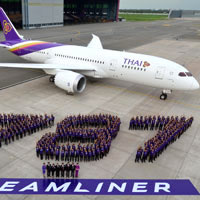
THAI Airways B787-8 gets the welcome treatment at Bangkok The Qantas 'Project Sunrise' is using its latest Dreamliner to test the impact on passengers and crew of ultra-long 20-22-hour nonstop routes from Sydney to New York and London. Researchers are measuring melatonin and sleep patterns with test subjects. These leg-numbing non-stops are expected to be launched in 2022. Air New Zealand is meanwhile scrapping its Los Angeles to London hop that links New Zealand with UK via the USA. The route has been in operation since 1982. But in 2020 a New Zealand to New York ultra-longhaul nonstop utilising a B787-9 Dreamliner will likely be in place. Did physical size matter? This was the crux of the Airbus vs Boeing debate. The larger, Airbus A380 wing design ensured future versions of the aircraft could handle a total weight of up to 750 tons. This meant the US$280m A380 would achieve optimum cost-efficiency carrying closer to 800 passengers. That’s a lot of beers and queues for the toilets – on two floors. Not perhaps what passengers wanted to hear. Of course, most airlines opted for a more sensible seating configuration. Singapore Airlines offers 471 seats and a standard configuration is 555 seats. It is a beast of a plane. Airports everywhere quailed at the prospect and raced to make accommodations. Heathrow’s Terminal Three underwent expensive redesign to accommodate the Airbus A380 and Emirates introduced oversized ground equipment in Dubai at its Terminal 3, which initially offered five aerobridges to suck out passengers from the Super Jumbo Airbus A380. The new aircraft is a space guzzler. It needs more runway to clear the ground, more taxiway for the sweep of its enormous 79m wingspan, and boarding gates need re-jigging to deal with the logistics of deplaning a swarm of passengers from a towering double-decker. On 12 April, 2011 the wingtips of a taxiing Air France A380 at New York’s JFK, struck the tail of a Delta commuter Comair flight, spinning the smaller plane around, proving once again, that might is right. 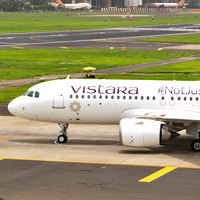
Indian skies: Vistara A320Neo The A380 coliseum alas failed to materialise, disappointing those who would love to toss all airline chefs to the lions, Christian or not. This chapter is now sadly closing. It is somewhat ironic that Boeing could have launched the very first double-decker aircraft over three decades ago. Pressed by visionary Pan Am founder Juan Trippe for large double decker aircraft, Boeing responded by designing the widebody B747, arguing that a two-storey aircraft would be plagued by far too many limitations. {The European Union Aviation Safety Agency (EASA) suggested temporary changes to stabilise the centre of gravity on A320Neo aircraft... Today it is more than likely that there is a market for both products, big and small. But the transatlantic diatribe continues. Boeing asserted earlier that Airbus competed, unfairly, through backdoor European subsidies. Yet, Boeing itself has been a major beneficiary of state and federal aid with Washington State bending over backwards to ensure the B-787 plant stays with them. Much of Boeing’s aircraft design has been a spin-off from US military-sponsored research. Now as the China dragon awakes, a new competitor is streaking across the horizon, bidding for a share of the small jet market for the expected regional travel explosion. The Chinese made ARJ21 (literally, the Advanced Regional Jet for the 21st Century) took shape in the Shanghai ACAC plant with a dash of Boeing factory knowhow, huge dollops of government subsidies and, more recently, a Bombardier stake. 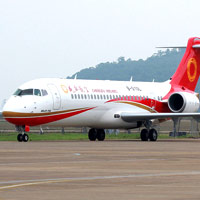
Chengdu Airlines ARJ21 The first aircraft were delivered to low cost Chengdu Airlines late November 2015. It received China certification after long delays but awaits its FAA certification by USA. The small Comac ARJ21 Xiangfeng (an A220 equivalent model) carries between 90 to 105 passengers serving regional airports in China and beyond. It should be particularly well adapted for short or high-altitude runways that require extra power or a sharp rate of climb. In China alone domestic airlines are expected to purchase almost 3,500 new aircraft by 2025. And then there's China's 164-seat C919, also from COMAC, the state-run Commercial Aviation Corp of China. It has been argued that much of the technology was hacked from the West for the fledgling C919 program though China has strenuously denied this. The C919 went through airworthiness trials and was ferrying passengers and competing with Boeing's 737 and the Airbus A320neo May 2023. The B737MAX grounding following the twin tragedies in Ethiopia and Indonesia. COMAC could be producing up to 150 C919s annually by 2025. Meanwhile, Mitsubishi, which shot to fame with its legendary Zero second world war jet fighter has unveiled its MRJ, or Mitsubishi Regional Jet. This is reportedly a very fuel-efficient machine with 70 to 90 seats. Backing it are the japanese government , Toyota and other firms. The MRJ has bagged 375 orders from airlines including ANA and SkyWest. Japan Airlines hopes to deploy some of these aircraft on domestic routes. The Canadian Bombardier regularly crosses swords in the small and mid-size single-aisle passenger jet market with Embraer the Brazilian conglomerate. Was big always beautiful? The prodigious and spectacularly ill-starred 12-engine Dornier Do-X was the world’s biggest aircraft in 1929, its hull accommodating a full three floors. The Wall Street crash ended its career despite a problem-plagued round-the-world PR stunt that took ten months to accomplish, achieving little in the end. 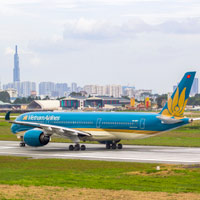
Vietnam Airlines B787 Dreamliner at HCMC's Tan Son Nhat International Airport By 1949, double-decker Boeing 377 Stratocruisers were plying the North Atlantic with opulent digs, and even living rooms, for first class passengers. No flat seat hype then. The B377 used real beds. And there was the memorable Howard Hughes “Spruce Goose” (H4 Hercules) that took to the skies, briefly, in 1947. This extraordinary flying boat arrived too late to aid in the war effort – its prime purpose – and was relegated to museum attraction. So, A380 or B787? B787 or A350? B737 MAX or A320Neo of the C919? Or, simply the lovable A220? Take your pick. Barring the hugely successful B747, aviation history has not been kind to passenger aircraft behemoths.
NOTE: Telephone and fax numbers, e-mails, website addresses, rates and other details may change or get dated. Please check with your dealer/agent/service-provider or directly with the parties concerned. SmartTravel Asia accepts no responsibility for any inadvertent inaccuracies in this article. Links to websites are provided for the viewer's convenience. SmartTravel Asia accepts no responsibility for content on linked websites or any viruses or malicious programs that may reside therein. Linked website content is neither vetted nor endorsed by SmartTravelAsia. Please read our Terms & Conditions. |


